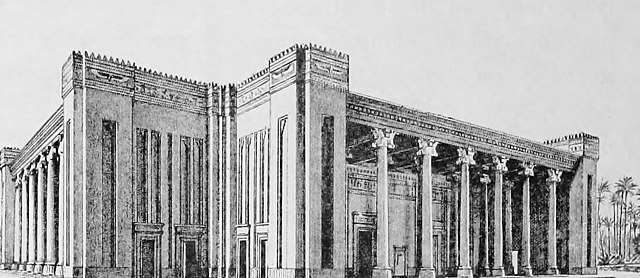Line 244:
Events mentioned in the [[Old Testament]] book of [[Esther]] are said to have occurred in Susa during the Achaemenid period. The King [[Ahasuerus]] mentioned in that book may refer to [[Xerxes I]] (486-465 BC).
=== GreekSeleucid period ===
[[File:The weddings at Susa, Alexander to Stateira and Hephaistion to Drypetis (late 19th century engraving).jpg|thumb|right|250px|The marriages of [[Stateira II]] to [[Alexander the Great]] of Greek [[Macedon]] and her sister, [[Drypteis]], to [[Hephaestion]] at Susa in 324 BC, as depicted in a late-19th-century engraving.]]
Susa lost much of its importance after the invasion of [[Alexander the Great|Alexander the Great of Macedon]] of Greece in 331 BC. In 324 BC he met [[Nearchus]] here, who explored the Persian Gulf{{Citation needed|date=May 2019}} as he returned from the Indus River by sea. In that same year Alexander celebrated in Susa with a [[Susa weddings|mass wedding]] between the [[Persians]] and [[Ancient Macedonians|GreeksMacedonians]].<ref>van Oppen de Rutter, Branko F., "THE SUSA MARRIAGES — A HISTORIOGRAPHICAL NOTE", Ancient Society, vol. 44, pp. 25–41, 2014</ref>
The city retained its importance under the Greek [[Seleucid]]s for approximately one century after Alexander, however Susa lost its position of imperial capital to [[Seleucia|Seleucia on the Tigris]] to become the regional capital of the [[satrapy]] of Susiana.<ref>{{cite book |last= Capdetrey |first= Laurent |title= Le Pouvoir Séleucide |location= Rennes |publisher= Presses universitaires de Rennes |year= 2007 | pages= 252 |isbn= 978-2-753505-24-7}}</ref> Nevertheless, Susa retained its economic importance to the empire with its vast assortment of merchants conducting trade in Susa,<ref>{{Citation|last1=Boyce|first1=Mary|date=1 January 1991|work=A History of Zoroastrianism, Zoroastrianism under Macedonian and Roman Rule|pages=35–48|publisher=Brill|language=en|doi=10.1163/9789004293915_004|isbn=9789004293915|last2=Grenet|first2=Frantz|title=On the Western Edge of the Iranian Plateau: Susa and Elymais}}</ref> using [[Charax Spasinu|Charax Spasinou]] as its port.
The city was named '''Seleucia on the Eulaeus''' or '''Seleucia ad Eulaeum'''.
[[Seleucus I Nicator]] minted coins there in substantial quantities.<ref>{{cite journal |last1=Marest-Caffey |first1=Laure |title=Seleukos I's Victory Coinage of Susa Revisited: A Die Study and Commentary |journal=American Journal of Numismatics |date=2016 |volume=28 |pages=1–63}}</ref> Susa is rich in Greek inscriptions,{{Citation needed|date=May 2019}} perhaps indicating a significant number of Greeks living in the city. Especially in the royal city large, well-equipped peristyle houses have been excavated.
=== Parthian period ===
Around 147 BC Susa and the adjacent [[Elymais]] broke free from the Greek [[Seleucid Empire]]. The city was at least temporarily ruled by the Greek rulers of the Elymais with [[Kamnaskires II Nikephoros]] minting coins there. The city may again have briefly returned to Seleucid rule, but starting with [[Phraates II]] (about 138–127 BC) to [[Gotarzes II of Parthia|Gotarzes II]] (about 40–51 AD) almost all rulers of the [[Parthian Empire]] coined coins in the city, indicating that it was firmly in the hands of the Parthians at least during this period. The city however retained a considerable amount of independence and retained its Greek city-state organization well into the ensuing [[Parthia]]n period.<ref>{{cite book |last= Hill |first= John E. |title= Through the Jade Gate to Rome: A Study of the Silk Routes during the Later Han Dynasty, First to Second Centuries CE |location= Charleston |publisher= BookSurge |year= 2009 |isbn= 978-1-4392-2134-1}}</ref> From second half of the first century it was probably partly governed by rulers of Elymais again, but it became Parthian once again in 215.<ref>Potts: ''Elam'', pp. 354-409.</ref><ref>{{cite book |last= Le Rider |first= Georges |author-link= Georges Le Rider |title= Mémoires de la Délégation archéologique en Iran XXXVIII: Suse sous les Séleucides et les Parthes |location= Paris |year= 1965 | pages= 349–430 }}</ref>
Susa was a frequent place of refuge for Parthian and later, the Persian [[Sassanid dynasty|Sassanid]] kings, as the [[Roman Empire|Romans]] sacked Ctesiphon five different times between 116 and 297 AD. Susa was briefly captured in 116 AD by the Roman emperor [[Trajan]] during the course of his [[Trajan's Parthian campaign|
|  Article Images
Article Images